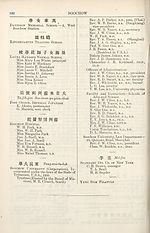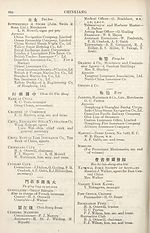1918
(909) [Page 833] - Chinkiang
Download files
Complete book:
Individual page:
Thumbnail gallery: Grid view | List view
![(909) [Page 833] - Chinkiang](https://deriv.nls.uk/dcn17/1949/0514/194905149.17.jpg)
CHINKIANG
a m Chin-kidng
The port of Chinkiang, which was opened to trade by the Treaty of Tientsin, is
situated on the south bank of the Yangtze, about 150 miles from its mouth, and
near the entrances of the southern and northern sections of the Grand Canal. This
position gave it formerly great importance and it was at one time believed that the
port must eventually become a serious rival to Shanghai. But the neglect of the
inland waterways, and especially of the Grand Canal, which is closed to steam
traffic for some months during each year, either because the water is too shallow
nr because it has risen so much that the wash from launches would injure the embank¬
ments, is causing the trade to be gradually diverted to Hankow and Tsingtao.
Now that the Tientsin-Pukow Railway is completed more of the trade will be diverted
to Nanking. A railway from Kwachow, at the mouth of the Grand Canal on the
north bank of the river, along the Canal to Tsingkiangp'u, is projected and may do
something to save the situation, but there are fourteen tax barriers along this
route and it remains to be seen whether this railway, if built, will not have the
same difficulty with the Likin officials as is now experienced by the Shanghai-
Nanking Railway. The north bank opposite the Concession is being eroded rapidly,
and a spit from the island of Cheng Jen Chou, to the west of the Concession, is
•extending eastwards, and threatens to become a grave inconvenience to shipping.
The future prospects of the port are, therefore, not so bright as they appeared a
few years ago.
Ohinkiang is one of the pleasantest ports on the river. It is now within a few
.hours’ railway journey of Shanghai, which' enables ice and other necessaries to be
delivered promptly, while the Shanghai morning paper is received the same afternoon.
The surrounding country is very pretty, and there is fair shooting, wild pig being
plentiful within a few miles of the Concession. An electric light installation was set
up by the Municipal Council in 1914 for the service of the Concession. The power used
for generating electricity at the same time pumps water into a water-tower. The
water, however, though now laid on throughout the Concession, is far from clear.
The population of the Native City is estimated at about 150,000. To the west
of the Concession is a handsome temple adorned with a pagoda standing on a con¬
spicuous elevation, and known as Golden Island. It is interesting to record that
in the time of Marco Polo this hill was on the north bank of the river. In 1842 it
was an island near the middle of the river, and the British fleet anchored where
•the railway station now stands. .
The net value of the trade of the port for 1916 was Hk. Tls. 19,944,071. There are
no local industries of importance, and the trade of the port is with the districts to the
north of the river. The Commissioner of Customs in a recent trade report opines that
it is probable that the port will gradually sink into insignificance and decay, owing to
•the railway facilities which are diverting its trade to Hankow, Kiaochow and Nanking.
DIRECTORY
Arnhold, H. E., Merchant — Tel. Ad :
Harchi
A. H. Rasmussen, agent
35 $0 35 A-si-a
.Asiatic Petroleum Co. (North China),
Ltd., The
E. G. Masters, local manager
P. J. Wilson
N. Keller
J. S. Shearer, installation manager t
pJ & £0 H Yin.mei.en-kung-sze
British American Tobacco Co., Ltd.—
Tel. Ad : Powhattan
E. D. Pearson, manager
British Municipal Council
G. C. Purton, chairman
E. G Masters 1 C. B. Gardner
W. Martinson, secretary
Police, Electric Light and Water Works
W. Martinson, superintendent
a m Chin-kidng
The port of Chinkiang, which was opened to trade by the Treaty of Tientsin, is
situated on the south bank of the Yangtze, about 150 miles from its mouth, and
near the entrances of the southern and northern sections of the Grand Canal. This
position gave it formerly great importance and it was at one time believed that the
port must eventually become a serious rival to Shanghai. But the neglect of the
inland waterways, and especially of the Grand Canal, which is closed to steam
traffic for some months during each year, either because the water is too shallow
nr because it has risen so much that the wash from launches would injure the embank¬
ments, is causing the trade to be gradually diverted to Hankow and Tsingtao.
Now that the Tientsin-Pukow Railway is completed more of the trade will be diverted
to Nanking. A railway from Kwachow, at the mouth of the Grand Canal on the
north bank of the river, along the Canal to Tsingkiangp'u, is projected and may do
something to save the situation, but there are fourteen tax barriers along this
route and it remains to be seen whether this railway, if built, will not have the
same difficulty with the Likin officials as is now experienced by the Shanghai-
Nanking Railway. The north bank opposite the Concession is being eroded rapidly,
and a spit from the island of Cheng Jen Chou, to the west of the Concession, is
•extending eastwards, and threatens to become a grave inconvenience to shipping.
The future prospects of the port are, therefore, not so bright as they appeared a
few years ago.
Ohinkiang is one of the pleasantest ports on the river. It is now within a few
.hours’ railway journey of Shanghai, which' enables ice and other necessaries to be
delivered promptly, while the Shanghai morning paper is received the same afternoon.
The surrounding country is very pretty, and there is fair shooting, wild pig being
plentiful within a few miles of the Concession. An electric light installation was set
up by the Municipal Council in 1914 for the service of the Concession. The power used
for generating electricity at the same time pumps water into a water-tower. The
water, however, though now laid on throughout the Concession, is far from clear.
The population of the Native City is estimated at about 150,000. To the west
of the Concession is a handsome temple adorned with a pagoda standing on a con¬
spicuous elevation, and known as Golden Island. It is interesting to record that
in the time of Marco Polo this hill was on the north bank of the river. In 1842 it
was an island near the middle of the river, and the British fleet anchored where
•the railway station now stands. .
The net value of the trade of the port for 1916 was Hk. Tls. 19,944,071. There are
no local industries of importance, and the trade of the port is with the districts to the
north of the river. The Commissioner of Customs in a recent trade report opines that
it is probable that the port will gradually sink into insignificance and decay, owing to
•the railway facilities which are diverting its trade to Hankow, Kiaochow and Nanking.
DIRECTORY
Arnhold, H. E., Merchant — Tel. Ad :
Harchi
A. H. Rasmussen, agent
35 $0 35 A-si-a
.Asiatic Petroleum Co. (North China),
Ltd., The
E. G. Masters, local manager
P. J. Wilson
N. Keller
J. S. Shearer, installation manager t
pJ & £0 H Yin.mei.en-kung-sze
British American Tobacco Co., Ltd.—
Tel. Ad : Powhattan
E. D. Pearson, manager
British Municipal Council
G. C. Purton, chairman
E. G Masters 1 C. B. Gardner
W. Martinson, secretary
Police, Electric Light and Water Works
W. Martinson, superintendent
Set display mode to:
![]() Universal Viewer |
Universal Viewer | ![]() Mirador |
Large image | Transcription
Mirador |
Large image | Transcription
Images and transcriptions on this page, including medium image downloads, may be used under the Creative Commons Attribution 4.0 International Licence unless otherwise stated. ![]()
| Asian directories and chronicles > 1918 > (909) [Page 833] - Chinkiang |
|---|
| Permanent URL | https://digital.nls.uk/194905147 |
|---|
| Attribution and copyright: |
|
|---|---|
| Description | Volumes from the Asian 'Directory and Chronicle' series covering 1917-1941, but missing 1919 and 1923. Compiled annually from a multiplicity of local sources and research. They provide listings of each country's active corporations, foreign residents and government agencies of all nationalities for that year, together with their addresses. Content includes: various treaties; coverage of conflicts; currencies and taxes; consular fees; weights and measures; public holidays; festivals and traditions. A source of information for both Western states and communities of foreigners living in Asia. Published by Hongkong Daily Press. |
|---|---|
| Shelfmark | H3.86.1303 |
| Additional NLS resources: |

